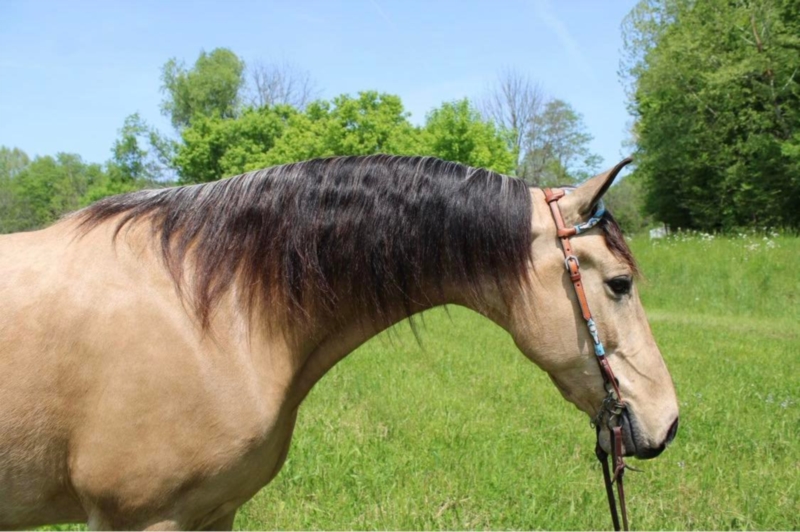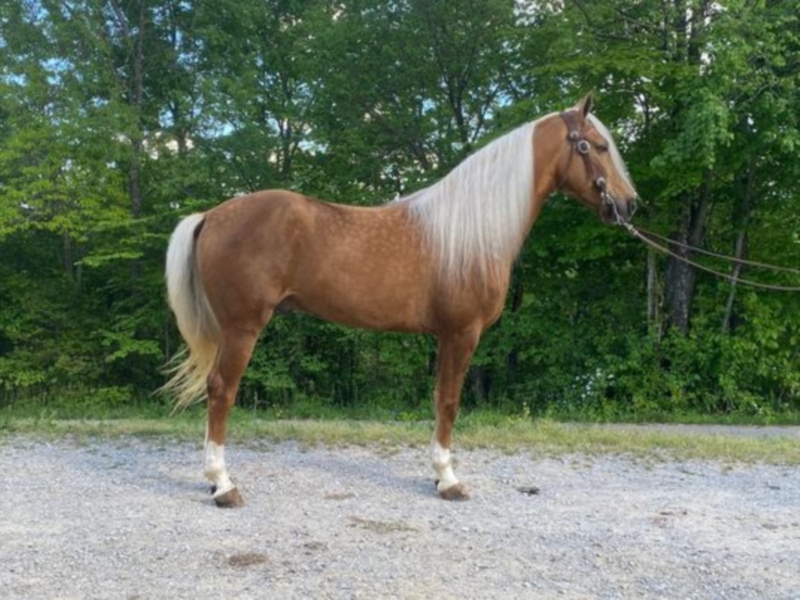The Tennessee Walking Horse is one of America’s loveliest horse breeds. A Tennessee Walker performing its natural running walk gait is an impressive sight. What’s more, these handsome, friendly horses are an excellent choice for families. Their comfortable gaits are ideal for all ages, including elderly and less able riders. The qualities of the Tennessee Walking Horse are recognized in its role as the state horse of Tennessee. It has an interesting history, too!
Tennessee Walking Horse – History and Origins
The immediate ancestor of the Tennessee Walking Horse (also known as the Tennessee Walker, or TWH) is the Tennessee Pacer. These horses were known from the late eighteenth century onwards. They were the descendants of horses introduced from Kentucky, making them close relatives of the Kentucky Saddler, which would in time become the American Saddlebred.
The breeds used to produce the early saddle horses included Narragansett Pacers and Canadian Pacers, as well as Spanish Mustangs, which were brought from Texas via Mississippi. Some of the early Pacer lines are known by name, such as those of the stallions Copperbottom and McMeen’s Traveler. The combination of Mustang hardiness and Pacer gaits resulted in great all-rounders, which were widely used on farms and plantations.
Far from simply being show horses, the Walking Horses were expected to perform various tasks, including riding, drawing plows and vehicles, and also racing. Their good looks and sure-footedness were also greatly appreciated. There has been a great deal of cross-breeding between Morgans, Standardbreds, Saddlebreds, and Walkers over the centuries, especially in the early days.
Why do Tennessee Walking Horses walk that way?
Tennessee Walking Horses are naturally gaited horses. Their ground-covering running walk is characteristic of most members of the breed. Their ability to perform it is also influenced by their hock conformation. This encourages the long overstep required to reach very fast speeds in running walk.
Black Allan, the Founding Father
It wasn’t until 1886 that the breed acquired its foundation stallion, from which all Tennessee Walkers claim descent. In that year, Black Allan, also known as Allan F-1 in the stud book, was born. His sire was the stallion Allendorf, a Standardbred from the famed Hambletonian line, and his dam a Morgan mare called Maggie Marshall.
The interesting thing about Black Allan is that he had admirable trotter and pacer ancestry, but he didn’t want to trot! He was a natural pacer. However, it had been hoped he would be a great trotter. He became a stud stallion and sired Roan Allan, a multi-gaited horse who was successful in the show ring and in many speed competitions.

The Tennessee Walking Horse comes in different colour variations
The Formation of the Breed Association
The breed began to be formally recognized with the creation of the Tennessee Walking Horse Breeders’ Association in 1935. The stud book has been closed since 1947 so that only horses that have both parents registered are eligible for entry themselves. By 1974, interest in showing meant that the TWH breeders changed the association’s name to the Tennessee Walking Horse Breeders’ and Exhibitors’ Association (TWHBEA). In 1950, the Tennessee Walking Horse became known as a distinct breed, recognized by the United States Department of Agriculture. In 2000, the elegant and versatile Walker became Tennessee’s state horse.
How much does a Tennessee Walking horse cost?
A TWH can cost as little as $2,500, but a successful performance horse for the show ring will cost much more, as will a registered stallion for breeding.
Tennessee Walking Horse – Conformation
The modern Tennessee Walking Horse has a reputation for being a very tall horse, with an elegant and impressive outline. While some are certainly tall, around 17 hands high (68 inches/173 cm), others are smaller. The minimum height is 14.3 hands high (59 inches/150 cm). Their conformation is an unusual combination of compact backs and long necks, shoulders, and hips. This enables them to have their unique stance and great length of stride. Their bottom line is longer than the top line.
What is also interesting, and unusual, is that cow-hocks or sickle-hocks are acceptable, where these are seen as a fault in other breeds. In the Tennessee Walker, these angulated hocks enable the horses to produce their amazing gaits, since they allow the back feet to overstep the front ones. Black is probably the color most associated with the TWH since this has been very popular in recent decades. In the mid-twentieth century, rich golden chestnut, or sorrel, was a popular color. In fact, they can be any solid color and also pinto-patterned. Dilution genes also produce coat colors such as the dun, cream, champagne, and silver dapple.

The appearance of the Tennessee Walking Horse can resemble a Quarter Horse or that of a Thoroughbred. It depends on the bloodline.
Characteristics of the Tennessee Walking Horse
The Tennessee Walking Horse is famous for its gaits, calm temperament, and good looks. They may look spectacular at a horse show, yet there is much more to these horses. They are so amiable, as well as comfortable to ride, that they can be high on the list of suitable horses for riders of any ability.
TWHs: Naturally Gaited and Fast!
Tennessee Walking Horses are specialists in the running walk. This is a four-beat gait, which corresponds to the footfall of a regular walk, but is much faster. (The regular walk is also known as a “flat walk.”) The main difference between the two is speed. A horse’s flat walk is rarely outside the range of 4 mph/6.4 kph an hour to 8 mph/12.9 kph an hour. This is where sickle or cow hocks can help in producing the running walk, allowing the horse’s back feet to overstep its front feet by anything up to a remarkable 18 inches/46 cm.
This long overreach can be a feature in other breeds, but it is particularly valued in the TWH. It gives them their amazing glide, which is so comfortable to ride. Another notable TWH feature is the way the horse nods its head rhythmically in running walk. While the TWH can also perform lateral ambling gaits, such as racking, stepping, fox-trot, and single-foot, these, and trotting, are not permitted in the show ring. Canter is a permissible show ring gait. Some Tennessee Walking Horses have powerful trots that can be utilized for endurance riding and other sports.

The Tennessse Walking Horse is between 14.3 hands high (59 inches/150 cm) and 17 hands high (68 inches/173 cm).
Breeding and Uses
Tennessee Walking Horses were originally bred to carry their owners over long distances in the saddle as they looked over their plantations and farms. This required horses with especially smooth gaits and the good sense to cope with everyday hazards and activities they would encounter. They were also expected to do a range of other tasks. Today, their performance skills and endurance are used in many equestrian sports. They are superb riding horses, good in harness, and excel in distance riding. They also have dedicated classes.
Types of Class: Flat Shod and Performance
In flat-shod classes, the horses wear regular shoes, or are barefoot, as appropriate. In this style, they can take part in a range of activities, including Western and English-style riding classes, plantation pleasure, and park pleasure classes. In performance classes, the horses have traditionally been encouraged to show the brilliance and height of their gaits using stacked pads. This exaggerated action is known as “the big lick,” and although widely condemned and even prohibited, it still occurs.
Diet and Nutrition
Tennessee Walkers are good-doers who thrive on grass, good-quality hay, and a little corn when in high performance. Since their natural action can be demanding on the feet and leg joints, they will also benefit from supplements, such as biotin or omega oils, especially as they age. They can be long-lived horses, and this will help them maintain their elegant, proud movements well into old age.
Are Tennessee Walking Horses good for beginners?
Tennessee Walking Horses can be a great choice for people starting out in riding, as they are comfortable to ride, very sensible, and easy to look after. .
Health and Behavior
Tennessee Walkers are generally very healthy horses. Their gene pool is large and they do not suffer from the types of genetic issues associated with rarer breeds. However, traditional practices, such as using nailed and stacked shoes, can cause major health issues like navicular disease and laminitis. They have no major behavioral issues, though they are said to sometimes be stubborn. This is probably simply a sign of their sensitivity, preferring riders who know how to negotiate with them.
Gait Controversy
Although TWHs are naturally gaited, various methods have been used to enhance the gait of competition horses. Some of these methods are very controversial. Indeed, they are banned by welfare legislation. The most controversial are techniques used to create the “big lick” in performance horses, which are intended to create an especially flamboyant running walk and canter.

